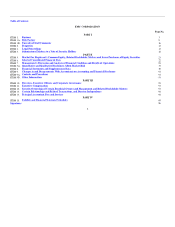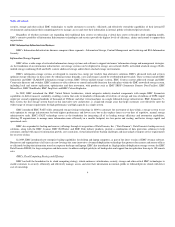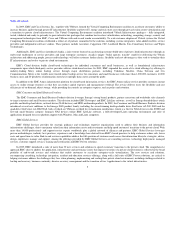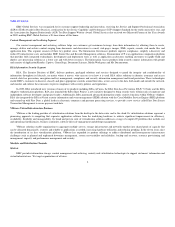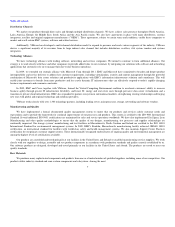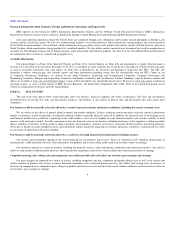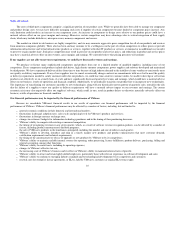EMC 2009 Annual Report Download - page 12
Download and view the complete annual report
Please find page 12 of the 2009 EMC annual report below. You can navigate through the pages in the report by either clicking on the pages listed below, or by using the keyword search tool below to find specific information within the annual report.
Table of Contents
• the timing and amount of capitalized software development costs beginning when technological feasibility has been established and ending when the
product is available for general release; and
• the recoverability of benefits from goodwill and intangible assets and the potential impairment of these assets.
Our stock price is volatile and may be affected by the trading price of VMware Class A common stock and/or speculation about the possibility of
future actions we might take in connection with our VMware stock ownership.
Our stock price, like that of other technology companies, is subject to significant volatility because of factors such as:
• the announcement of acquisitions, new products, services or technological innovations by us or our competitors;
• quarterly variations in our operating results;
• changes in revenue or earnings estimates by the investment community; and
• speculation in the press or investment community.
The trading price of our common stock has been and likely will continue to be affected by various factors related to VMware, including:
• the trading price for VMware Class A common stock;
• actions taken or statements made by us, VMware, or others concerning the potential separation of VMware from us, including by spin-off, split-off
or sale; and
• factors impacting the financial performance of VMware, including those discussed in the prior risk factor.
In addition, although we own a majority of VMware and consolidate their results, our stock price may not reflect our pro rata ownership interest of
VMware.
We may be unable to keep pace with rapid industry, technological and market changes.
The markets in which we compete are characterized by rapid technological change, frequent new product introductions, evolving industry standards and
changing needs of customers. There can be no assurance that our existing products will be properly positioned in the market or that we will be able to
introduce new or enhanced products into the market on a timely basis, or at all. We spend a considerable amount of money on research and development and
introduce new products from time to time. There can be no assurance that enhancements to existing products and solutions or new products and solutions will
receive customer acceptance. As competition in the IT industry increases, it may become increasingly difficult for us to maintain a technological advantage
and to leverage that advantage toward increased revenues and profits.
Risks associated with the development and introduction of new products include delays in development and changes in data storage, networking
virtualization, infrastructure management, information security and operating system technologies which could require us to modify existing products. Risks
inherent in the transition to new products include:
• the difficulty in forecasting customer preferences or demand accurately;
• the inability to expand production capacity to meet demand for new products;
• the impact of customers' demand for new products on the products being replaced, thereby causing a decline in sales of existing products and an
excessive, obsolete supply of inventory; and
• delays in initial shipments of new products.
Further risks inherent in new product introductions include the uncertainty of price-performance relative to products of competitors, competitors'
responses to the introductions and the desire by customers to evaluate new products for extended periods of time. Our failure to introduce new or enhanced
products on a timely basis, keep pace with rapid industry, technological or market changes or effectively manage the transitions to new products or new
technologies could have a material adverse effect on our business, results of operations or financial condition.
The markets we serve are highly competitive and we may be unable to compete effectively.
We compete with many companies in the markets we serve, certain of which offer a broad spectrum of IT products and services and others which offer
specific information storage, content management, security or virtualization products or services. Some of these companies (whether independently or by
establishing alliances) may have substantially greater financial, marketing and technological resources, larger distribution capabilities, earlier access to
customers and greater opportunity to address customers' various IT requirements than us. In addition, as the IT industry consolidates, companies may improve
their competitive position and ability to compete against us. We compete on the basis of our products' features, performance and price as well as our services.
Our failure to compete on any of these bases could affect demand for our products or services, which could have a material adverse effect on our business,
results of operations or financial condition.
11



